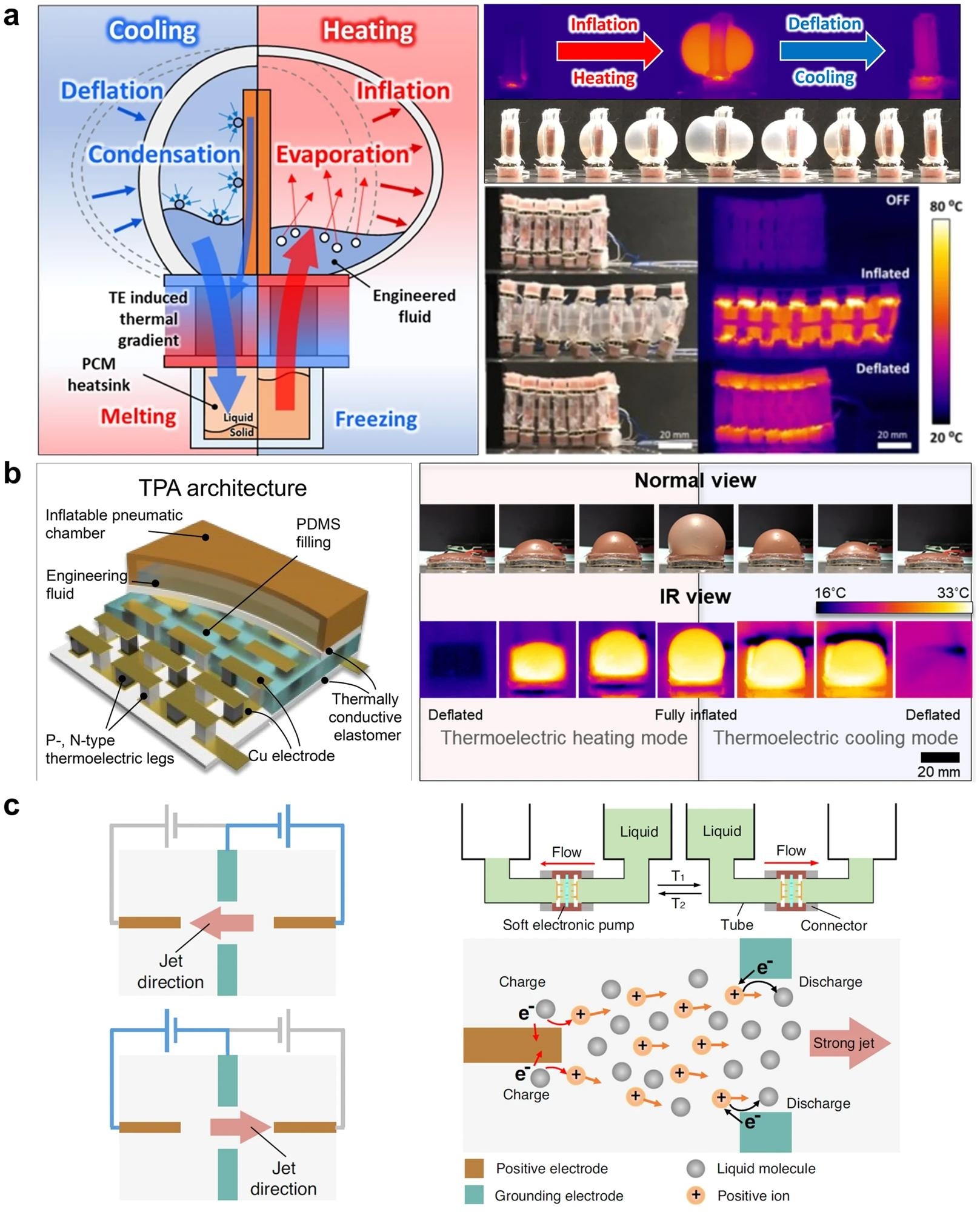In a recent article published in the journal Nature Communications, researchers reviewed the advancement and challenges of untethered soft actuators, which can drive soft robots independently without external wires or tubes. They classified these actuators into different categories and discussed their strengths, limitations, and future perspectives. Additionally, they presented a comprehensive comparison of various types of soft actuators and emphasized notable works within the field.
 a Pumpless thermoelectric pneumatic actuator and soft earthworm robot. Reproduced with permission from ref. 34, copyright 2023, Elsevier BV. b Soft robotic fish based on the thermoelectric pneumatic actuator. Reproduced with permission under CC BY 4.0 license from ref. 35. c Soft electronic pump and robotic fish/vehicle based on the soft electronic pump. Reproduced with permission under CC BY 4.0 license from ref. 48. Image Credit: https://www.nature.com/articles/s41467-024-47639-0
a Pumpless thermoelectric pneumatic actuator and soft earthworm robot. Reproduced with permission from ref. 34, copyright 2023, Elsevier BV. b Soft robotic fish based on the thermoelectric pneumatic actuator. Reproduced with permission under CC BY 4.0 license from ref. 35. c Soft electronic pump and robotic fish/vehicle based on the soft electronic pump. Reproduced with permission under CC BY 4.0 license from ref. 48. Image Credit: https://www.nature.com/articles/s41467-024-47639-0
Background
Soft robotics represents a rapidly evolving field dedicated to creating flexible, deformable, and adaptable robots that mimic the characteristics observed in biological organisms. Unlike conventional rigid robots that rely on heavy and bulky structures, soft robots employ materials capable of mechanical deformation in response to diverse stimuli like pressure, light, heat, or electricity. These characteristics empower soft robots to navigate complex environments, delicately manipulate objects, and interact safely with humans.
However, soft robotics faces challenges, particularly regarding the power sources and actuation mechanisms essential for executing functional movements. Many current soft robots depend on external pumps, wires, or tubes to furnish the mechanical force for soft actuators, thereby restricting their mobility and functionality. Therefore, there is a pressing need for the development of untethered soft actuators capable of functioning without physical links to external power sources.
About the Research
In this review paper, the authors conducted a comprehensive analysis of recent advancements and emerging trends in untethered soft actuators for soft robotics. They organized soft actuators into four primary categories based on their operational mechanisms: pneumatically/hydraulically driven, magnetically driven, heat-driven, and electrically driven. Within each category, they detailed the operational principles, utilized materials, innovative approaches, and notable examples of untethered soft actuators. Additionally, the researchers compared the performance metrics of different soft actuators, including response time, output force, actuation range, and adaptability to varying environmental conditions.
Moreover, the study delved into integration strategies for incorporating soft actuators into soft robotics, such as integrating soft sensors, energy storage components, and energy harvesters, as well as employing fabrication techniques like origami-based methods, four-dimensional (4D) printing, or programmable magnetization.
The paper also outlined the prospects of untethered soft actuators across diverse applications, including bio-inspired designs, micro/nanoscale robots, and dynamic/reconfigurable structures. The authors illustrated these prospects with examples of untethered soft robots exhibiting functionalities such as locomotion, manipulation, sensing, and communication, thereby underscoring the promising future of untethered soft robotics.
Research Findings
The study highlighted the promising potential of untethered soft actuators across various applications in soft robotics, including bio-inspired designs, micro/nanoscale robots, and dynamic/reconfigurable structures. Each type of soft actuator was examined, revealing distinct advantages and disadvantages:
- Pneumatically/hydraulically driven soft actuators were capable of generating significant mechanical force and achieving high actuation speeds. However, they often required bulky pumps or fluid chambers or relied on phase transition processes that consumed substantial thermal energy, resulting in slower response times.
- Magnetically driven soft actuators offered precise spatial manipulation and adaptability through remote control. However, they faced challenges in manipulating magnetic fields for complex three-dimensional (3D) movements, particularly over extended distances.
- Heat-driven soft actuators demonstrated the potential to convert thermal energy into mechanical work, thereby reducing energy consumption and providing passive actuation capabilities. However, they were sensitive to environmental temperature fluctuations, which could affect their performance and accuracy and might pose safety concerns in high-temperature environments.
- Electrically driven soft actuators provided rapid response times and high force output, seamlessly integrating with electronic devices and drivers. However, they could exhibit sensitivity to electrical interference, electromagnetic fields, and power supply stability. Additionally, they required high operating voltages that could lead to dielectric breakdown.
Applications
The paper suggests that untethered soft actuators can be applied to various fields, including biomedical engineering, aerospace engineering, environmental engineering, and consumer electronics. Some potential implications include:
- Exploration of underwater and deep-sea environments, as well as outer space, where human access is limited or dangerous.
- Minimally invasive surgical procedures, drug delivery systems, and tissue engineering applications requiring biocompatibility, flexibility, and precision.
- Biomimetic soft robots capable of mimicking the locomotion and behavior of natural organisms like fish, worms, insects, or plants, leveraging bio-inspiration, adaptability, and intelligence.
- Soft robots capable of altering their shape, color, or texture in response to external stimuli such as light, heat, or humidity, offering advantages in terms of reconfigurability, camouflage, and imperceptibility.
Conclusion
The article summarized that untethered soft actuators represented both significant advancements and challenges in the realm of soft robotics. They offered opportunities for developing soft robots capable of functioning without external connections to power sources. The authors emphasized that untethered soft actuators could address critical limitations seen in conventional soft robots, including constraints on mobility, functionality, and autonomy. However, they also acknowledged the limitations and challenges.
Moving forward, the researchers recommended that future efforts should concentrate on enhancing the performance, efficiency, reliability, durability, and scalability of untethered soft actuators. Additionally, they proposed focusing on the development of new materials, designs, and fabrication techniques to enable more intricate and varied functionalities and behaviors.